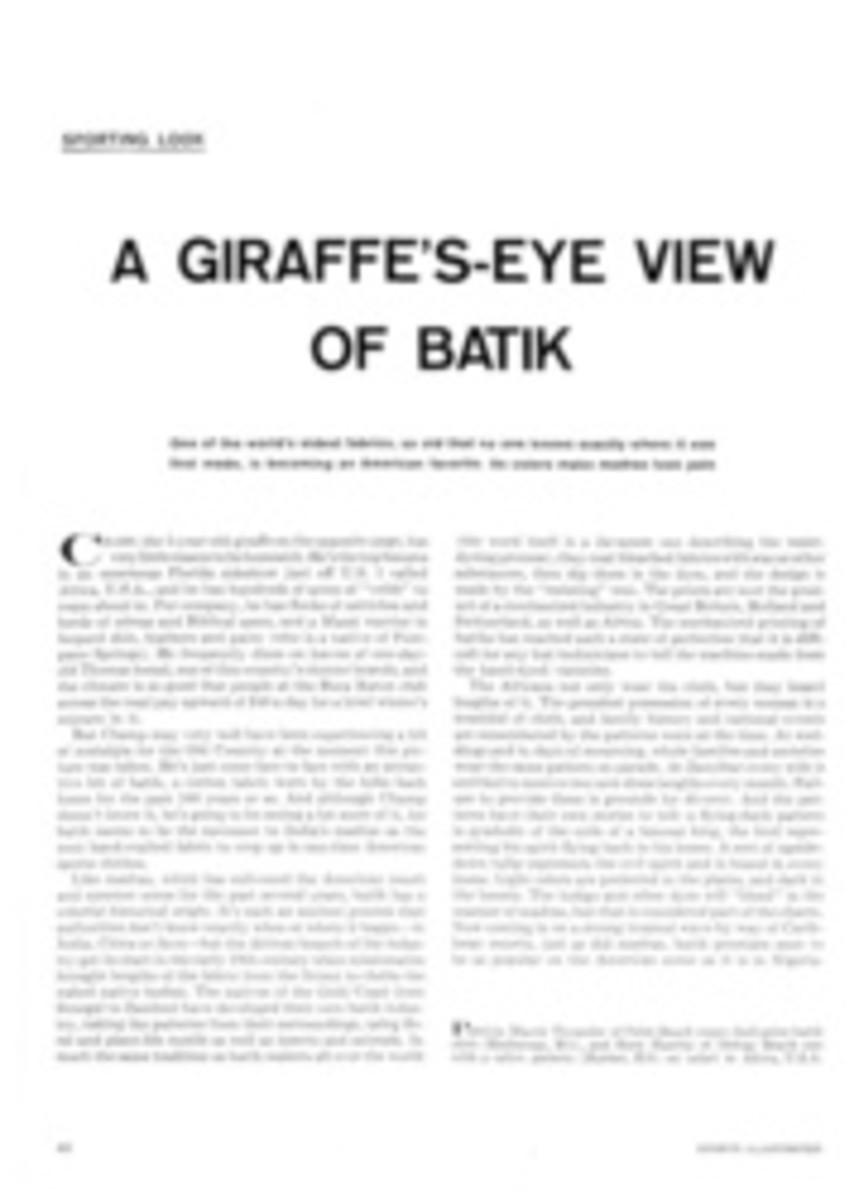
JUNE IN JANUARY
Flying down to Rio, an early discovery of those two explorers, Ginger Rogers and Fred Astaire, seems a particularly agreeable idea at this season of the year, now that the full flush of summer has come to the upside-down lands below the Equator. (I have often wondered if romantic tenors down there don't sing, "It's January in June because I'm in love.")
Copacabana Beach, which stretches across a considerable expanse of SPORTS ILLUSTRATED this week, stretches as well along a considerable length of the south Atlantic. Bikinied brasileiras bake upon it, carioca children fly kites with fluttering wings above it, athletic types water-ski along its fringes and the ploom-ploom of the volleyballs sound from dawn to dusk the year around. Its bordering boulevard is embellished with a swirly mosaic sidewalk, and behind that is a cliffside of white buildings hung with terraces that offer distant dreamy dioramas that seem to stretch clear to South-West Africa on the far side of Capricorn.
Although this magnificent facade along the seaside Avenida Atlantica is rather reminiscent of the Promenade des Anglais at Nice, relatively few of these white castles are hotels. By far the most elegant is the Copacabana Palace, ensconced, like a caravansary in Cannes, across the road from the sand and the sea. Its nights are filled with frilly entertainment imported from the velvety supper clubs in the U.S., and by day its terrace suites overlook the pool and a patio of apricot trees and red awnings supported by arms of polished brass. Dinner for one will cost about $10 in its Bife de Ouro, where you can come by filet de badejo bonne femme; picadinho, a loosely packed chopped meat sautéed with rice; or an ice cream soda. The rate for both meals and rooms will be less at the Excelsior, which is just as modern if more modest.
The local language being Portuguese, and English not nearly as much practiced as it is along the Croisette, it might be handy to know that while corn flakes are corn flakes, puffed wheat is flocos de trigo, the favorite beer is Chopp, chicken is frango and turkey, bless me, is peru.
With that amount of Berlitz under the belt, one might be safely dispatched to Sacha's, a small and smoky candy box on the beach which sports El Morocco stripes, atmosphere, prices and continuous boom-chick music. With both minimum and cover charge included (most Rio clubs charge both) dinner would come to about $6 with tip. Drinks are nearly $2 each. For pure local color you might thread your way for lunch to the Alba Mar at 184-18.6 Mercado Municipal, an address that will take you to the markets overlooking the harbor. A two-man elevator will lift you to the premises, where the view gives on to the hooting ferryboats and to the planes zooming into the domestic Aeroporto Santos Dumont.
I might add at this point that the downtown area is separated from the Copacabana, or resort section, by six miles and a number of hills, each of which is crowned, like all the 200 hills of Rio, by a thatch of shanties and a communal samba school. The hills blocking the route to the beach have been bored with shiny tunnels, and taxis will make the long excursion for the equivalent of 50¢. Cabs and cars negotiate the boulevards as if it were Memorial Day in Indianapolis, and a pedestrian who gets hit is sued by the driver.
Anyone who would feel safer aboard a streetcar (local expression: bonde) will find the ride slow, dependable and cheap. For 2¼¢ & trip you can ride an open trolley in the middle of Rio's winter (July), or ride that other Rio oddity, a streetcar named Meyer. Trolley cars travel both to Sugar Loaf and Corcovado, Rio's two prime tourist sights. From the trolley stop it takes two cable cars to get to Sugar Loaf and a cog railway to reach Corcovado.
Corcovado and its crowning statue of Christ the Redeemer can be seen from the stands of the Jockey Club, an elegant raceway that was built in 1926 to replace the first one, which was established in 1870. Although you need a tie to get in, you can bet as little as 20 cruzeiros (30¢). You can bet vencedor (win) or placé (place), but there are no show bets and, indeed, sometimes place bets are not paid. If the racing pales there is always the view, a magnificent vista not only of Corcovado on the extreme left but of the hills—the Hill of Longing For, the Hill of the Kid Goats, the Hill of the Rooster Crow and, in front of them, the still waters of the Freitas Lagoon. From a modernistic grandstand of their own, 20,000 sculling enthusiasts can watch races on the lagoon. Some sculls are raced under floods at night.
But by far the biggest house count in Rio is racked up at the Estadio do Maracan√£, built in 1950 for the international football tournament. It can offer seats to 150,000 rabid Rio partisans, and there is room for another 50,000 to stand in the areaway between the last row seat and the beginning of the moat. The moat is a trench adapted from the constructors of castles to prevent the frenzied fan, spurred by temperament or tippling—there are 54 bars in the stadium—from invading the field.
Besides Brazil nuts, seated, standing or edible, the vast land also grows a variety of stones, notably aquamarines. A good (but not top) grade 12-karat aquamarine a half inch square might cost $150, but if you are dissatisfied after arriving home the gems can be returned to contacts in the States. The Brazilian gem merchants are only too happy to have the stones imported for them duty-free. At any rate, aquamarines and various other kinds of sparklers can be made up in splendid rings; and as earrings they work out as rather an attractive way of having rocks in your head.
PHOTO
ORMOND GIGLI
WATER SKIERS Lilian Lobo (left) and Lucia Contalice skim the powder foam stirred up by runabout off Copacabana Beach.
PHOTO
ORMOND GIGLI
SAILBOATS, like beach-front apartments and Corcovado peak (center), are indispensable to Rio's scenery. These Star boats from late Clube are cruising Copacabana waters.
PHOTO
ORMOND GIGLI
SAND SPORTS LIKE FRESCO BALI, (BELOW) TOP SWIMMING IN POPULARITY AT COPACABANA DESPITE THE 90° SUMMERS FROM THE HEART OF RIO ANYBODY CAN GET TO A BEACH IN A MATTER OF MINUTES-AND JUST ABOUT EVERYBODY DOES
PHOTO
ORMOND GIGLI
SURFBOARDS, because of rough Atlantic water, attract only the hardiest of swimmers. Jim Connell (center), Pan-American pilot, introduced long U.S.-style board to region.
PHOTO
ORMOND GIGLI
VOLLEYBALL set finds open space for game on the fine white sand at Ipanema beach, just three miles to the south of crowded Copacabana area.
PHOTO
ORMOND GIGLI
SPEARFISHING for grouper at Arpoador Point, Italian Film Actress Elena Portello receives some instruction on the handling of her spear gun.
PHOTO
ORMOND GIGLI
SWINGING in the shade of a Brazilian almond tree in the sandy backyard of Rio, a youngster takes an upside-down look at Copacabana Bay.

